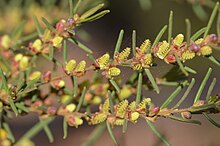bio.wikisort.org - Plant
Bertya gummifera[4] is a sticky shrub[4] in the family Euphorbiaceae, endemic to New South Wales.[4][5][6] It grows in woodland and often in sandstone areas.[4] It flowers in spring.[4]
| Bertya gummifera | |
|---|---|
 | |
| Dandry Gorge, in the Pilliga, NSW | |
 | |
| Tab XVI A[1] | |
| Scientific classification | |
| Kingdom: | Plantae |
| Clade: | Tracheophytes |
| Clade: | Angiosperms |
| Clade: | Eudicots |
| Clade: | Rosids |
| Order: | Malpighiales |
| Family: | Euphorbiaceae |
| Genus: | Bertya |
| Species: | B. gummifera |
| Binomial name | |
| Bertya gummifera | |
 | |
| Occurrence data from Australasian Virtual Herbarium | |
| Synonyms[3] | |
|
Bertya gummifera var. genuina Müll.Arg. | |
Description

Bertya gummifera is a sticky shrub, growing from 1–2 m high.[4] The young growth is covered long whitish hairs, which sometimes persist on the stems, but most of the plant loses these and becomes rough and hairless with age.[4] The rough-surfaced leaves are 10–50 mm long and about 2 mm wide, and have margins which are rolled downwards from the upper surface (revolute). The flowers (with and without stalks) are crowded, and have 5-8 bracts. The male flowers have triangular outer bracts which are shorter and less broad than the inner bracts and the perianth segments are about 4 mm long and a reddish brown. The female flowers have narrower bracts, and their perianth segments enlarge and enclose the fruit.
The capsule is up to 12 mm long and about 7 mm in diameter.[4] The species was first described as Bertya gummifera by the botanist Jules Émile Planchon in 1845.[1][2]
References
- Planchon, J.E. in Hooker, W.J. (1845) Description de deux genres nouveaux de la famille des Euphorbiacees. London Journal of Botany 4: 473, t. 16A
- "Bertya gummifera". Australian Plant Name Index, IBIS database. Centre for Plant Biodiversity Research, Australian Government.. Accessed 22 June 2019.
- Govaerts, R. et al. (2019) Plants of the world online: Bertya gummifera. Board of Trustees of the Royal Botanic Gardens, Kew. Accessed 22 June 2019.
- "Bertya gummifera R.Br". PlantNET – FloraOnline. National Herbarium of NSW. Retrieved 2019-06-22.
- "Bertya gummifera – Occurrence records". The Australasian Virtual Herbarium. Council of Heads of Australasian Herbaria. Retrieved 2019-06-22.
- Barrett, R. (2017) Bertya gummifera. In: Flora of Australia. Australian Biological Resources Study, Department of the Environment and Energy, Canberra. Accessed 22 June 2019.
External links
- Bertya gummifera Occurrence data from the Australasian Virtual Herbarium
- Bertya gummifera PlantNET – Description
Другой контент может иметь иную лицензию. Перед использованием материалов сайта WikiSort.org внимательно изучите правила лицензирования конкретных элементов наполнения сайта.
WikiSort.org - проект по пересортировке и дополнению контента Википедии